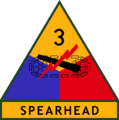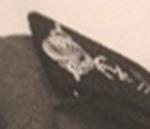-
Posts
432 -
Joined
-
Last visited
-
Days Won
1
Content Type
Profiles
Forums
Blogs
Gallery
Events
Store
Everything posted by GRA
-
Hello Noor! I think it is a national cockade m/51 (not sure about the year, it could have been the company/squadron badge that was m/51, they were worn together), it was in any case used with the m/60 and m/87 dress uniforms until recently, before the garrison cap gave way to the beret. They were worn up to the rank of corporal, after that there was a three-piece combination without enamel (in different colours and designs for NCOs, officers, generals and certain regiments). Some years ago you could pick these up by the dozen, and always new and unissued. /Jonas
-

Sweden Swedish / Nordic Badge ? Military ?
GRA replied to Linasl's topic in Northern European & Baltic States
Only enough to get me a beer, I'm afraid, but I've been working on my Czech skills since last summer when I moved here! /Jonas -

Sweden Swedish / Nordic Badge ? Military ?
GRA replied to Linasl's topic in Northern European & Baltic States
You're welcome! If you need something translated from Swedish, just post it (I might be able to manage Norwegian and Danish too, but Swedish is my native language, so no problem there). /Jonas -

Sweden Swedish / Nordic Badge ? Military ?
GRA replied to Linasl's topic in Northern European & Baltic States
Hello Linas! Well, I have no idea what this cross is all about, but if it is Swedish (at least it is made in Sweden, by Sporrong), it might well have a Värmland connection (see picture for Värmland coat of arms). By the look of the fastening device, I'd say that it is quite recent in manufacture. I'm not sure it originates from the Värmland regiment (I2, 2nd Inf Regt), their traditional colours were yellow and black, and Bergslagens artilleriregemente (A9, 9th Arty Regt) had another coat of arms... Maybe civilian? Värmland /Jonas Värmland province coat of arms I2 A9 -

Horse Furniture
GRA replied to Stuart Bates's topic in Great Britain: Militaria: Badges, Uniforms & Equipment
Hello Stuart! Are you sure you are dealing with regular cavalry here? It might be yeomanry or other volunteers too. A quick look in W.Y. Carman's "Light Horse and Mounted Rifle Volunteers 1860-1901" yields a plume identical to the 8th Hussars plume, worn by the Light Troop, Honourable Artillery Company (officer's chargers), and a red plume for the 1st Middlesex Light Horse (officer's chargers, print published 1860). Patrick Mileham's "The Yeomanry Regiments" shows a Lt-Col of the City of London Yeomanry (Rough Riders), where the horse furniture includes a red plume, dated 1911. The City of London Yeomanry was associated to the Lancers 1908-1920, and the officer wears a lancer uniform. Just a thought... /Jonas -
"If someone could remind me of the medals that the ribbons represent?" - The first one is Ceskoslovensky valecny kriz 1918 (Czechoslovak War Cross 1918). The second one looks Russian? Could it together with the chevrons indicate service in both WW 1 and in the civil war of Russia? A nice piece of history you've got there! /Jonas
-
Fortifikationsofficerarnes Idrotts- Och Fältridtklubb - "Fortifications officers sports and riding club", this particular spelling was common around 100 years ago, but more an indicator of when this jeton was first put into use than an age indicator as such, the design could have been use for a long time (possibly even after change of spelling - "tradition"). Is there any dating or makers marks on it? Has it been glued to something? (It looks like it has been fastened to something before, something a previous owner did, or something deliberately done before awarding it?) /Jonas
-
I've no idea about the value of this badge, I don't even know whether it's OK or not (as I mentioned above, I've seen pictures of this badge in almost any gold-silver combination wings-handle-wreath-shield-blade except the one in the post). However, it seems like (according to Krubl's book) that observer badges lacks the wreath, pilot's and letovod (air traffic control?) badges comes with the wreath. I'm sorry I can't be of more assistance. /Jonas
-
Hello Befehl227! The pattern are the one used 1968-1992, but I can't find the exact match (silver blade, the rest gold) in my copy of Krubl's Ceskoslovenske & Ceske Vojenske Odznaky. /Jonas
-

1st Battalion 15th Yorkshire Regiment
GRA replied to Fairygenes's topic in Great Britain: Research, Documentation & History
Hello Dale! You might find this link of interest as to the regiment of your relative: 15th (the Yorkshire East Riding) Regiment of Foot /Jonas -
Hello vikmas! If I recall correctly, the crown on the collar means a field-grade officer, thus major up, so he would not be a 2nd Lieutenant (especially not with what looks like a Sword Order on the ribbon bar). I'm not sure, but the second ribbon could be a medal for participating in the Winter War in Finland. I've tried to identify the button, but no luck yet (my older uniform regulations are "hidden" somewhere, and the newer has significantly less patterns of buttons). /Jonas
-
Hello vikmas! It could very well be an officer's version, since you say it is made from better material. Would you mind posting a photo of a button to hopefully make it possible to identify the unit (officers and NCO's, being professionals, would wear regimental buttons as opposed to conscripts)? /Jonas
-

WORLD FLAGS PRE- 1914
GRA replied to Mervyn Mitton's topic in Great Britain: Research, Documentation & History
Hello Mervyn! I'd say that this cloth most certainly were made before 1905, since the Swedish and Norwegian flags shown were used during the Union, which ended in 1905. The Swedish union flag were used 1844-1905, and the Norwegian union flag 1844-1899. Are there any more give aways as to dating the cloth? /Jonas -

British helmets collection
GRA replied to pjac's topic in Great Britain: Militaria: Badges, Uniforms & Equipment
Hello Patrick (and Simon)! There's a couple of photos of a Fife Light Horse helmet in W.Y. Carman's "Light Horse And Mounted Rifle Volunteers 1860-1901" where the plume reaches to the lower part of the rose mount of the chinstrap, if that is of any assistance. In the same book there's also a drawing of a trooper whose plume is an inch or two longer, just to confuse matters! /Jonas -

VICTORIA CROSS 'MYSTERY'
GRA replied to Mervyn Mitton's topic in Great Britain: Orders, Gallantry, Campaign Medals
I don't think he was Norwegian as Norway and Sweden were two countries in a personal union (two parliaments,one king) at the time, if Brown was Norwegian he'd certainly have proudly stated that fact when signing up for service. One thought, Rick is on to an interesting theory as to the name, but what if he had one of these "impossible" Scandinavian names? The truth could very well be that if he had brown hair, he'd settle for Brown at sign-up. Brun (Brown) is a possible name on both sides of the Norwegian-Swedish border, in Sweden it could well indicate him having an ancestor (father?) who served as an allotted soldier in Sweden, but again as Rick says, -son names were the common practice in Sweden then (or -dotter for women). As to Brown's age when winning the VC, weren't there even younger recipients? /Jonas Edit: Wikipedia states his year of birth as 1837, thus giving him a perhaps more plausible age. http://en.wikipedia.org/wiki/Peter_Brown_(VC) -
Hello RobC! It's the badge/patch of the 3rd Armored Division, later samples also has a rectangular tab "Spearhead" (black on gold) beneath. (image from Wikipedia) Greetings/ Jonas
-

Czechoslovakia Czech Pilots Badges?
GRA replied to Gordon Craig's topic in Central & Eastern European States
Hello Gordon! Sorry, but I don't know much more than that. My impression is that these badges were awarded after having reached a certain level of knowledge/professionalism, and I assume the criteria differed between specialties. I don't know how served time influenced, but I can't recall having ever seen a photo of a conscript private sporting the Mistr badge. There are tank proficiency badges too, which runs along the same lines. To complicate things, there were also badges awarded for "Exemplary Soldiers", as well as the usual shooting badges, parachute qualification badges etc. Maybe there's someone on the forum that has actually served in the Czechoslovak Army who can spread a little light on the award criteria? Greetings, /GRA -

Czechoslovakia Czech Pilots Badges?
GRA replied to Gordon Craig's topic in Central & Eastern European States
Hello Gordon! Yes, they're Czech allright, but not pilot's badges. They're general proficiency badges used 1968-92. The 1-2-3 class can be found at any junk stand or aspiring army surplus shop in Czech Rep these days, but the Master (M for Mistr) is not that easily found. I'm looking forward to add a Mistr badge to my collection too one day, just to get the set complete. Greetings, /GRA -
Hello all! @ Ed: That UNGOMAP clasp would be plausible at least to Swedish regulations, which states that the ribbon of the mission the recipiend originally belonged to is worn with a clasp added if seconded to another mission (like UNGOMAP, this very example is stated in the 1996 regulations). As far as I know, the early Congo missions of the 60s were issued with a clasp to the UNTSO-style ribbon before the 1963 ONUC ribbon without a clasp. I?m not sure if that Congo clasp existed as a miniature clasp, though I once saw someone wear the full size clasp on a miniature. I think the French sometimes wear UN medals with clasps too, like UNPROFOR. Perhaps a national deviation from the international regulation? /GRA
-
@ noir 7: Why wear a brevet like that when a fully qualified para? I thought that a PMP brevet would be relegated to the drawer when once awarded the "big thing". /GRA
-
Just a speculation, but could the unit badge on the shoulder board be the unit he was assigned to or the unit he?s about to be assigned to, since he seems to wear the training unit badge on the pocket? Do I see a backing to the parachutist?s brevet? Nice pics Simon, makes one want to experience that tingling feeling of jumping again... /GRA
-

Help to identify unit from WW2
GRA replied to lavagna's topic in Great Britain: Militaria: Badges, Uniforms & Equipment
Hello lavagna! I?d say "the chap" is a captain of the Reconnaisance Corps. Is it possible to get a closer look at the capbadge of the man with the moustache, and the patch of "the chap"? Greetings/GRA -

British Order of Battle
GRA replied to Christian L's topic in Great Britain: Research, Documentation & History
Hello Christian! Have you tried the Naval & Military Press website? They have quite a lot of reprinted books, and I wouldn?t be surprised if they have covered this subject too. Greetings/GRA -

Highlanders badges - period ? Value ?
GRA replied to ukok's topic in Great Britain: Militaria: Badges, Uniforms & Equipment
Hello ukok! Sounds like Warwickshire yeomanry? /GRA








